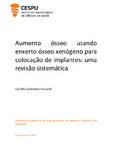Mostra i principali dati dell'item
Aumento ósseo usando enxerto ósseo xenógeno para colocação de implantes: uma revisão sistemática
| dc.contributor.advisor | SANTOS, MARIA ARMINDA OLIVEIRA DE SÁ | |
| dc.contributor.author | Ferrand, Gai Mai Valentine | |
| dc.date.accessioned | 2023-11-22T11:09:25Z | |
| dc.date.available | 2023-11-22T11:09:25Z | |
| dc.date.issued | 2023 | |
| dc.identifier.uri | http://hdl.handle.net/20.500.11816/4361 | |
| dc.description.abstract | Introdução: A disponibilidade óssea é o principal pré-requisito para a colocação do implante. Isto leva à utilização de enxertos ósseos nos casos de falta de ósseo e o material ideal deve cumprir os seguintes requisitos: osteocondutividade, osteoindutividade, e a presença de células osteogénicas. O enxerto ósseo autógeno é considerado a referência, mas existem outras classes de enxertos: aloenxertos, xenoenxertos e aloplásticos. Objetivo: O objetivo principal é relacionar os dados científicos das cirurgias regenerativas utilizando enxertos ósseos xenógenos e analisar as suas vantagens, indicações e complicações. O objetivo secundário é comparar estes resultas com o «gold» standard. Material e metodos: Foi realizada uma pesquisa bibliográfica nas bases de dados Pubmed/MEDLINE utilizando as seguintes combinações de palavras-chave: ("implantes dentários", "substitutos ósseos", "transplante ósseo", "perda óssea alveolar", "aumento da crista alveolar", "heteroenxertos", "auto-enxertos") NÃO ("mandíbula", "cães", "carga imediata de implantes dentários"). Entre os artigos publicados entre 2012 e 2022 em inglês, foram encontrados 67 artigos e 11 foram selecionados para este estudo. Resultados: No total, 233 pacientes foram submetidos a 320 procedimentos de regeneração ossea, nomeadamente a preservação dos alvéolos, a preservação da crista alveolar e ao aumento do seio maxilar. A média do ganho ósseo foi de 2,6 mm, variando de 0,81 a 5,7 mm e 9 estudos relataram dados de reabsorção numa média de 2,18 mm. A taxa de complicações menor foi de 35%, sendo a deiscência foi a mais frequente. Além disso, o volume ósseo alcançado permitiu a colocação de implantes com sucesso em 96% dos casos. Conclusão: Os enxertos ósseos xenógenos, independentemente da técnica e das formas de utilização apresentaram uma elevada taxa de sucesso sem grandes complicações. No entanto, o osso autógeno ainda é o gold standard porque é o único que induz propriedades de osteocondutividade no osso. | pt_PT |
| dc.description.abstract | Background: Bone availability is the main prerequisite for implant placement. This leads to the use of bone grafts in cases of bone shortage and the ideal one must fulfil the following requirements: osteoconductivity, osteoinductivity, and the presence of osteogenic cells. The autogenous bone graft is considered the reference but there are other classes that include allografts, xenografts and alloplasts. Aim: The main objective is to relate the scientific data of regenerative surgeries using xenogenic bone grafts and to analyse their advantages, indications and complications. The secondary objective is to compare these results with the gold standard. Materials and methods: A bibliographic search was performed in the Pubmed/MEDLINE databases using the following keywords combinations: ("dental implants", "bone substitutes", "bone transplantation", "alveolar bone loss", "alveolar ridge augmentation", "heterografts","autografts") NOT "mandible", "dogs", "immediate dental implant loading"). 11 articles were selected for this study published between 2012 and 2022. Results: A total of 233 patients underwent 320 bone regeneration procedures, namely socket preservation, alveolar ridge preservation and maxillary sinus augmentation. The mean bone gain was 2.6 mm, ranging from 0.81 to 5.7 mm and 9 studies reported resorption data at a mean of 2.18 mm. The rate of minor complications was 35% and dehiscence was the most frequent. Furthermore, the bone volume achieved allowed for successful implant placement in 96% of cases. Conclusion: Xenogeneous bone grafts, regardless of the technique and forms of use have shown a high success rate without major complications. However, autogenous bone is still the gold standard because it is the only one that induces osteoconductivity properties in bone. | pt_PT |
| dc.language.iso | por | pt_PT |
| dc.rights | info:eu-repo/semantics/openAccess | pt_PT |
| dc.subject | Dental implants | pt_PT |
| dc.subject | Bone substitutes | pt_PT |
| dc.subject | Xenografts | pt_PT |
| dc.subject | Maxilar bone loss | pt_PT |
| dc.title | Aumento ósseo usando enxerto ósseo xenógeno para colocação de implantes: uma revisão sistemática | pt_PT |
| dc.type | info:eu-repo/semantics/masterThesis | pt_PT |
| dc.identifier.tid | 203358864 | pt_PT |
| thesis.degree.name | Mestrado em Medicina Dentária | pt_PT |

